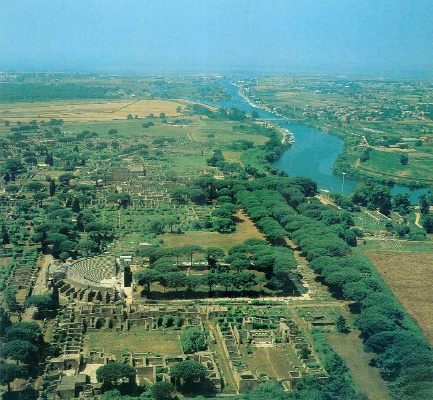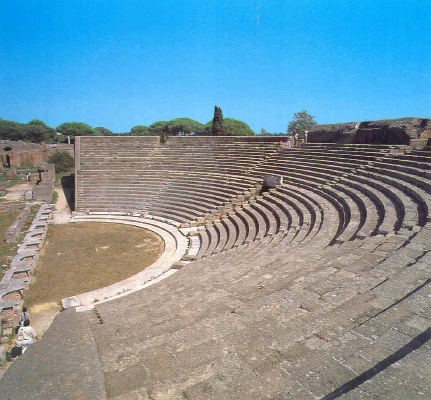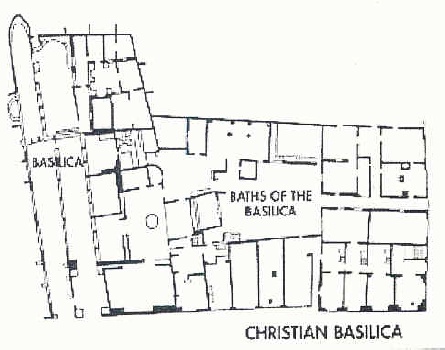Contenuto
Percorso : HOME > English > Pilgrims > OstiaOstia: St. Monica's Tombstone

Ostia Antica: the roman village
Ostia: St. Monica's Tombstone
Just outside the entrance to Ostia Antica is the small village of contemporary Ostia Antica. The parish church of St. Aurea, an early Roman Christian martyr, is served by a community of Augustinian friars. Located in an enclosed case in an alcove off of the right aisle of this church is a portion of St. Monica's marble tombstone. The Church was erected at the end of the fifteenth century.
In the early 1940's, toward the end of World War II, some young boys were playing soccer in a field near the old port city. One of them tripped and when he looked for the cause of his hall, he found a piece of marble protruding from the earth. Upon closer examination by the civil authorities, it became clear that he had literally stumbled upon an incredibly important artifact. Cleary inscribed on the stone was the information that this was indeed, a part of St. Monica's burial marker.
She had died of malaria at Ostia in 387 at the age of fifty-six.
"You are to butry your mother here ... Lay this body anywhere, and take no trouble over it. One thing only do I ask of you, that you remember me at the altar of the Lord wherever you may be."
(The Confessions, IX, 27)
The Ostia Road
Upon entering the scavi or the ruins of Ostia Antica, the first physical contact that one has with the ancient port city of Rome is that with the flagstones of the Via Ostiense along which extends a small section of the ancient necropolis or cemetery. There are the remains of mausoleums, once adorned with rich architectural decorations, and now quite barren because of the wear of time and the inexperience and recklessness of individuals in search of valuable funeral tombs. Notwithstanding the vandalism over time, it is still possible to identify in those structures the essential outlines of the family tombs of Ostia's well-to-do citizens. The Via Ostiense somewhat parallels the Tiber River. There is about a twelve mile distance between Ostia and Rome. When Augustine first arrived in Ostia from Carthage in 383, he arrived at this port city and would than have traveled to Rome either by taking this road or a barge up the Tiber River. The emphasis here is on the road, being on the way. It is an important point of reflection for pilgrims, especially upon entering Ostia Antica.
(The Confessions, Book V, 14 and 15)
GOD'S PROVIDENCE: Augustine had his reasons; God had His
"... your deep secret providence was at work ... you provided both the goads at Carthage that dislodged me from there and the allurements at Rome that attracted me; ..."
(The Confessions, Book V, 14)
"You knew all along, o God, the real reason why I left to see a different country, but you did not reveal it either to me or to my mother, ... the same night I left by stealth; she did not, but remained behind praying and weeping."
(The Confessions, Book V, 15)
The Roman Gate or Entrance to Ostia
The Via Ostiense ends at the Roman Gate. At first, it might seem strange that the gate leading into Ostia Antica is given this name. It all depends upon one's perspective. This is the gate that leads from Ostia to Rome. In the city of Rome are the remains of a similar gate named La Porta Ostiense because it is the gate through which one leaves Rome to travel on the Via Ostiense to Ostia Antica. And so one of the main roads in the city, the Decumanus, begins once passes through this gate.
Once thorough the gate, there is a large square where the cisiarii (cart drivers) who were in charge of the service between Ostia and Rome, stopped and parked. To the left of the square are remains of a large pool or fountain; to the right, a large warehouse from the republican period of Rome may be noted with both the columnar portico and several rooms. It preceded the find Roman bath complex of the cisiarii.
The Great Decumanus
Excavations (scavi) have helped to define an urban structure typical of all Roman towns. They were developed as fortified places; they were crossed by a Cardo (north - south axis) and a Decumanus (west - east axis), at whose junction there was a square called the forum (from Latin, foras, that is, outside, because the first public area of Rome, the 'Forum Boarium' was situated outside the inhabited center. Most of the places described below are either on or just off this important road in Ostia. It is helpful to note the many examples of beautiful examples of mosaic flooring in the original buildings along the Decumanus.
PESEVERANCE IN PRAYER: Monica's persistence in prayer.
"For me too a scourge was waiting there, in the guise of a bodily illness that brought me to death's door .... my mother, who knew nothing of this, persevered ill prayng for me; ... I recovered my bodily health, though I remained sick in my sacrilegious heart."
(The Confessions, Book V, 16 )
The Baths of Neptune
This is but one of the many baths located in Ostia Antica. It is a well divided, functional building which still has one of the most grandiose mosaics as for composition in the whole city. Located in the main room is a representation of the 'Triumph of Neptune'. Driving four pawing seahorses, he is encircled by a procession of sea monsters. The mosaic of the adjacent room represents the queen of the sea, Amphitrite, driven by Hyman and four Tritons (one no longer visible) who play cymbals.
As a Roman citizen, Augustine frequented the baths and comments on them both in his Confessions and again in bis Rule. They were part or the every day life of the people of his time. In this particular ruins, the location of the Frigidarium, the Laconicum, the Calidarium, the Gymnastic fields, the Cisterns and the Praefurnium are clearly identifiable.
The Christian monument
Along the Decumanus, near the Amphitheatre, one can identify a monument that honor's Ostia's third century martyrs among whom the most famous is St. Aurea for whom the Augustinian church is named. Originally, that church was a basilica, built in the necropolis (cemetery) of the Via Ostiense, and erected about her tomb.
Also honored on this monument is St. Monica who died in the city while waiting to embark for Africa in 388. Ostia's Christian community must have been substantial and very active, despite the scarce information which has come down to us, if, as St. Augustine mentions: "... it was the most famous among Rome's outlying dioceses" and again, "... the bishop of Ostia from time immemorial has the right to consecrate one elected to St. Peter's cathedra ..."
Considerable traces of Christian life still appear among the ruins. Christians symbols decorate many buildings: fish, doves and chalices are variously represented in mosaic or in sculpture as a votive act. Christian oil lamps have been found among the ruins of the city.

Ostia: the roman amphitheater
TRUST IN GOD Monica's faith in the words of the bishop.
" ... leave him alone ... Simply pray for him to the Lord .... it is inconceivable that he should perish, a son of tears, like your ."
(The Confessions Book III, 21)
The Amphitheater
Built in 12 B.C. at the time of August in blocks of tufa, this amphitheatre was enlarged and restructured in 196 A.D. in order to increase its capacity to 3500 people. During the late empire, it underwent new restorations and also was stuccoed and painted. Traces of this antique restoration may be noted in the fallen fragments along the Via delle Corporazioni. It was also adapted for aquatic shows by flooding the low zone called the orchestra. The water necessary for flooding was collected in two large cisterns set up in the two taverns facing the Decumanus.
This was one of the first buildings to be excavated at the end of the nineteentb century because its ruins emerged from the ground. Its present aspect refers to 1940 after the reconstruction. The brick outer ring is completely 'new' while the columns supporting the seating date back to Augustus at the end of the first century. In Augustine's time, the typical feature of the Roman theatre was that the audience could have access below the tiers while the seats of the Greek theatre leaned against a decline of the hill. The 1940's reconstruction took place to prepare for the Universal Exhibition of Rome in 1942.
This was cancelled because of World War II. However, now, in the summertime, classical theatrical sbows are held in the amphitheatre. The acoustics are remarkable.
Would Augustine have attended shows here, either when he first arrived at the port in 383 or the year he left Ostia in 388? As he passed by this building, he must have recalled his youthful addiction to the spectacoli (shows) as he does in his Confessions, Book 111,2: "I was held spellbound by theatrical shows full of images that mirrored my own wretched plight and further fueled the fire within me." Sections 2, 3 and 4 of Book III offer a worthwhile reflection on the effect that theatrical performances can have on one's emotions.
The Forum or the Corporations: Ostia's merchants and entrepreneurs
On the left side and to the rear of the Amphitheatre is the Via delle Corporazioni, the center of Ostia's commercial life. All business connected with maritime affairs were conducted in one or more of the many shops located along this street. The mosaic inscriptions in the flooring specified the publicized the various commercial and maritime activities in which each merchant dealt. The ships reproduced in the mosaics are cargo ships used for transporting merchandise from the supply centers scattered around the Mediterranean basin.
In Book IX of his Confessions, just before telling the story of his mother's last illness and death,he writes:
"You gather like-minded people to dwell together, and so you brought into our fellowship a young man names Evodius, who was from our home town. While serving as an administrative officer in the Special Branch he had been converted to you before we were; he was then baptized and abandoned his secular career to enlist in your service. We stayed together, and made a holy agreement to live together in the future. In search of a place where we could best serve you, we made arrangements to return as a group to Africa. And while we were at Ostia on the Tiber, my mother died."
(The Confessions, Book IX, 17)
Waiting for favorable winds, Augustine no doubt booked passage on a ship going from Ostia to Carthage. Very likely, it could have been in one of the shops along this road. In the mosaic flooring, one can read the word Kartaga (Carthage) and view ships possibly indicating the shop of a travel agent.

Ostia: The Christian Basilica
The Christian Basilica
The Christian Basilica was constructed the end of the fourth and beginning of the fifth century inside a building once used as baths. According to some, it was supposed to be the church of St. Peter and St. Paul of the Constantinian era, referred to in ancient texts; according to others, it could possibly be the location of a small church (left) next to a baptistery (right). St. Augustine and St. Monica may have worshipped here.
Today, one can see two narrow and long spaces, once separated by five columns; they preceded the two aisles ending with apses dug in niches.
The Confessions Book IX, 17 - 22 (Augustine writes or Monica's story)
CHRIST, THE INNER TEACHER
"Such was she, because you, her intimate teacher, instructed her in the school oh her heart. "
(The Confessions Book, IX, 21)
A typical second story apartment in Ostia
Some of the buildings in the ruins have stairs leading to a second story. It was in such a lodging that Monica and Augustine stayed waiting to return to their homeland in Africa. One day, while resting there together, they were gifted with a mystical experience. Augustine describes this moving experience with great detail in the Confessions.
"... she and I happened to be alone, through the mysterious workings of your will, as I believe. We stood leaning against a window which looked out on a garden within the house where we were staying at Ostia on the Tiber, far there, far from the crowds, we were recruiting our strength after the long journey, in preparation for our voyage overseas. We were alone, conferring very intimately. Forgetting what lay in the past, and stretching out to what was ahead, we is inquired between ourselves in the light of present truth the Truth which is yourself, what the eternal life of the saints would be like."
(The Confessions, Book IX, 23 -26 )
The latrine or public toilets
The public toilet is in an apartment building but was for the use of passersby. Its sewer system was in common with another inside latrine in the same building. A long bench with twenty holes that went all along the walls welcomed the wayfarers. A small water drain allowed greater hygiene. The two small doors that faced the street connecting the forum with a small square called 'Forum of the Heroic Statue' were pivoted at the middle of the threshold so that turning on themselves they offered a minimum of privacy.

